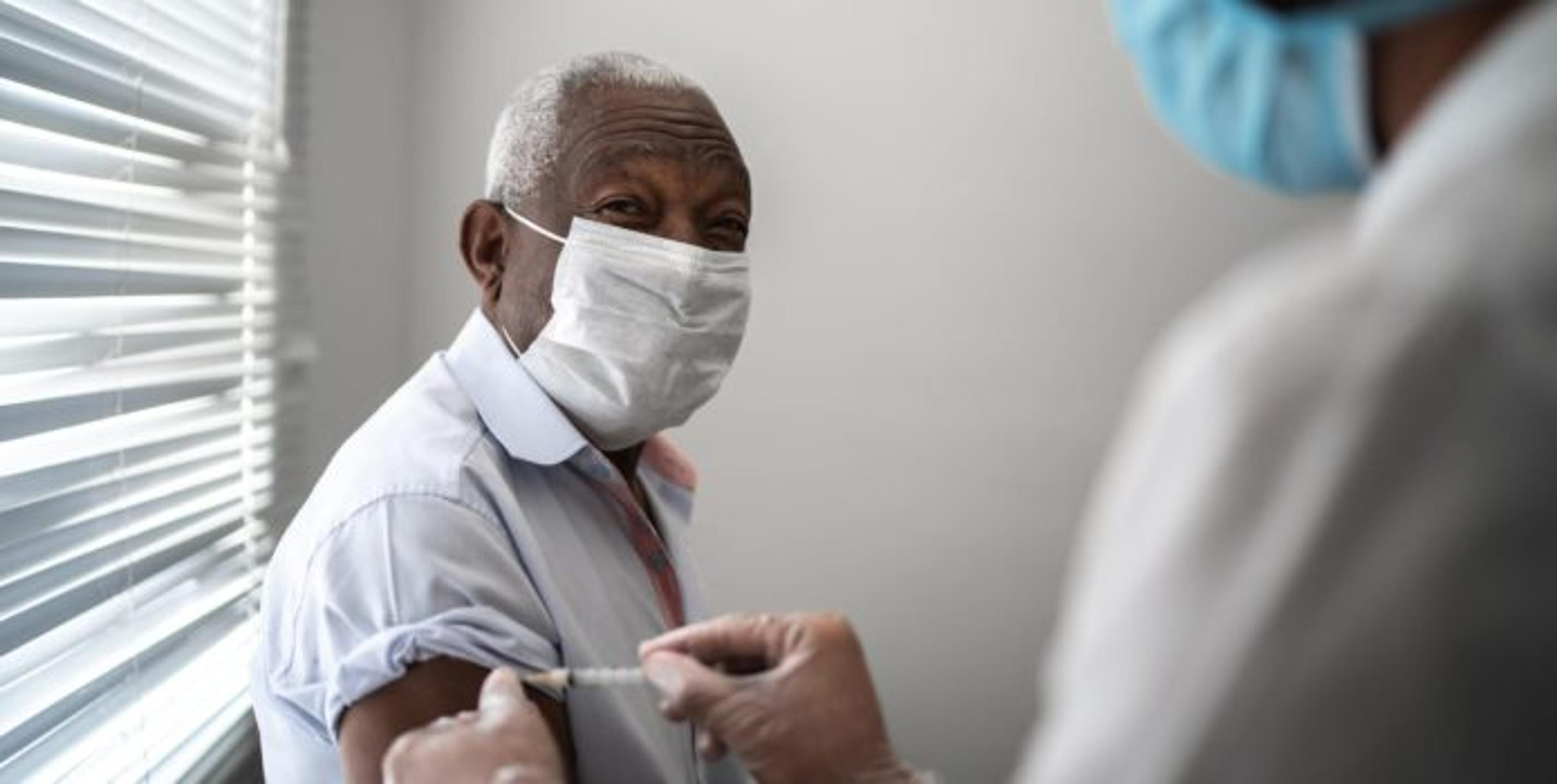COVID-19 Vaccine – What We Know

00:00
00:00
About the Show
-
- How the vaccine was developed.
- When the vaccine will be available to you.
- What it will take to get to herd immunity
- How will the vaccine be paid for when it’s time for me to get it.
Transcript
Here is the full transcript of this episode. You can listen to the audio version on streaming platforms or watch on YouTube.
This is A Healthier Michigan Podcast, episode 71. Coming up, we discuss what we currently know about COVID-19 vaccines.
Welcome to A Healthier Michigan Podcast. This is a podcast dedicated to navigating how we can improve our health and well-being through small, healthy habits we can start right now. I’m your host, Chuck Gaidica. Every other week, we’ll sit down with a certified health expert from Blue Cross Blue Shield of Michigan. We’ll dive into topics that cover nutrition and fitness, a whole lot more, as you know. And on this episode, we’re discussing what we know, what we think we know, but we’re going to get to some expert advice about what we really know about COVID-19 vaccines as the first wave of distribution has begun, and we hear more are coming. With us today is the senior vice president and chief medical officer for Blue Cross Blue Shield of Michigan, Dr. Jim Grant. How are you, Doctor?
Good. How are you, Chuck?
You know, I’m doing well. Thank you. I know you’ve got such a rich background in the state, out of the state. You’ve served as the President of the American Society of Anesthesiologists, currently serving as Chair of the Delegation and Section Council on Anesthesiology. I’m glad I’m getting the word right, close anyway. That’s to the American Medical Association. So I know you were here and then the west coast, and now back again, and we’re so delighted to have you with us because here we are. Some of what we’re talking about is in the rear view mirror already, middle of may Operation Warp Speed was officially announced by the US government to facilitate, manufacture, distribute COVID-19 vaccines. And while it couldn’t come fast enough, for many of us, this goal of delivering the first supply by the end of 2020 seemed fanciful, like how in the world could this happen? And now that we’re getting 2020 in the rear view mirror, and we’re at the beginning of a new year, still some questions, still some concerns, but also this idea about a lot of hope with more manufacturers coming to bear right with these COVID 19 vaccines.
So if you want to get a little wonky, we can take five, six hours, it’s all up to you, but I really want you to help us understand the background of these vaccines and how we’ve seen them developed and made available to the public so quickly.
Chuck, that’s actually a really good question. First, I think many people may be wondering how did this vaccine come about so quickly? A few things have contributed to the speed at which the vaccines have been actually authorized. Vaccines usually take 10 to 15 years to develop through phases and human trials. A factor that actually helped the quick development in this vaccine is that scientists had already begun research for coronavirus vaccines during the previous outbreak from SARS. We used to call it severe acute respiratory syndrome. That earlier research, because of the similarities, really provided us with a solid headstart for rapid development of this vaccine to protect against the infection with COVID. We had this research and knowledge and then Operation Warp Speed came out. We approved vaccine projects that could be submitted to the FDA as they go, instead of submitting one step then two steps and three steps and four steps, we sort of ran them all in parallel.
And why have we not done that in the past? Why is this sort of breaking new ground in that sense? Obviously there was a lot of weightiness to this whole idea. Let’s get it done. We need it quickly, but why haven’t we done this as you go process with the FDA? Are you aware?
Well, I can only assume it’s because we’ve never had a crisis like this. We’ve never had millions of Americans affected by something, hundreds of thousands of Americans dying from a disease, so we had to sort of alter the processes. Another factor that helped Operation Warp Speed is the financial backing efforts to start manufacturing doses while clinical trials were still ongoing. That means when those vaccines do get authorized, which now we have at least two of them that are authorized. They all have been a store of doses and once we got the go ahead, they were on the planes and ready to go.
Well, you know what that reminds me of, it’s kind of like during the holidays, Doctor, if you were in the kitchen making coffee, back in the old days, when we could all gather for Thanksgiving, Christmas, whatever, and you would poke your head around the corner from the kitchen and go, “Hey, it’s coming. Five minutes, I’ll have a pot of coffee.” We kind of had a feeling that it was coming. And like you said, doses were being already manufactured bottles had to come in, labels. I mean, there was a lot going on that we would hear in dribs and drabs, but it’s so cool to think that this was actually happening. And for many of us, there was a comfort factor and knowing it’s coming, it’s coming, and now it’s here.
Now it’s here.
Yeah. And what about safety? What about the safety of these vaccines?
You know, Chuck, as far as the safety of the vaccines go, this is the one message I want to leave with people. The FDA puts every vaccine or drug through rigorous testing and only releases those that are deemed safe. Our state officials are saying that while scientists worldwide are working to develop the vaccine faster and faster, we’re still continuing to go with proven processes and no one’s taking any shortcuts in the process to make sure that the vaccines are safe.
And as part of that, reflecting back to what you talked about, this idea that they were getting, these pharmaceutical companies getting approvals along the way, instead of having to wait years for this process, that seems to have sped things up, right?
That sped things up, like I said, in the manufacturing that was going on in parallel. So once we got the go-ahead from the FDA and the CDC, the trucks were loaded, then the planes were taking off.
We know we’ve got multiple manufacturers that are rolling these out and maybe still more to come. But as these vaccines roll out in waves, how will I know, I’m two years older than my wife, then we’ve got kids and then my kids have kids. How are we going to know when a vaccine is available for us?
Well, Chuck it’s really going by phases. The vaccine distribution really varies from state to state and federal government is giving the states the authority to determine the distribution. In the state of Michigan, there’s two phases. The first phase has three subsets; Phase One A, Phase One B, and Phase One C. Let me just go over those briefly so everyone knows where they’d fall.
Yeah, sure.
So Phase One A includes both paid and unpaid persons serving in healthcare settings who have both direct and indirect exposure to patients or infectious materials, or really, they’re unable to work from home as well as residents from long-term care facilities. Then we moved to Phase One B, Phase One B includes some workers in essential and critical industries with unique skillsets, non-hospital or non-public health employees, mortuary science. Phase One C, that includes individuals, again, over 16 years or older who are at high risk for severe COVID-19 illness due to underlying medical conditions, people over 65, then we’ll move to phase two, where we’re going to vaccinate the entire general population of those over 16 and hopefully the total general population we’ll get to in phase two by summer.
Things are still developing rapidly. Timelines could change. We’re continuing to monitor the state’s website for the Department of Health and Human Services. We’ve never vaccinated such large numbers of people at once. And remember too, this requires two shots. So we’ve got to make sure we’ve got things going in parallel. So there’s a lot that we’re learning and we’re getting millions of people vaccinated. Give us some time and we’re doing our best to get to the entire population.
So there’s a phrase that we’ve heard almost right from the beginning. And I think for me, I won’t speak for everybody, this phrase, herd immunity. At the beginning, I thought that meant, well, everybody’s got to catch it. Everybody’s got to get it so that they’ve got their own built-in immunity. And therefore, when you’re around, if you’ve already had it, you can’t get it at least for a time, whatever that means. But herd immunity also applies to vaccinations. Doesn’t it?
It does, Chuck. And I like to use the example of people coming over to your house for dinner. Let’s say you invite 10 people over. And nine of them are either immune or have been vaccinated. If those nine are already vaccinated, then that 10th person doesn’t have that same anxiety about getting the disease because they’re not really exposed to anyone who’s contagious. That’s what herd immunity is. That will give us our best chance to return to our normal activities. Government expects that the vaccines will be available to the general public by summer. We’re already in distribution. We’ve got to get as many people vaccinated now as we can.
And so when the government talks about this idea of getting us through this point of herd immunity, picture the same dinner party you’re talking about here. I don’t know that a 4th of July barbecue is going to be timely this year for us to feel safe. I’m trying to picture how everybody in the room, what do we all do? Give each other a thumbs up, like we already got the vaccine, “Hey, I’m good.” Are we all going to wear a pin? It’s going to be an interesting time, isn’t it?
It’s going to be interesting. And Chuck, it’s so many things in our life. We know that on July 4th, we’re going to have Independence Day. We know that on April 15th, we’re going to pay our taxes. It’s not like we’re going to have a specific date, take off your masks, you don’t have to social distance, hug everyone like you used to. It’s going to be watching the numbers, looking at the trends, seeing how incidents are going down and seeing what hospital admissions are like, seeing our number of ICU beds that are being occupied. So it’s sort of process of evolution.
There have been varied numbers that you see different polls that have been going on. And I don’t mean political polls, but surveys, I guess, is a better way to describe them, about how many people are willing to get a vaccine. What are you hearing about those numbers and what do you suggest we should be thinking about either trying to kick the numbers up a bit to get toward this herd immunity or otherwise?
All of our numbers are pretty consistently saying that about 60% of Americans are saying they’re going to get the vaccine. And that’s actually what we’re hearing from our members of Blue Cross Blue Shield also. Public health officials are really working hard to get accurate information to the general public about the vaccines. There’s a lot of questions out there. And really, the number of people that are vaccinated will have to increase so that we can get a meaningful level of immunity in the population. And once we get that, once the numbers start going down, then life is going to start looking a little more normal.
Yeah. And as this rollout continues in the state of Michigan, let’s talk about that in particular. Are there any folks that you see should be raising their hand and really questioning if they should be getting the vaccine? And I know there will be varied manufacturers, so maybe one is better for somebody let’s say over 65, we discover in the research. But beyond that, who should be concerned about receiving the vaccine, if anyone?
Chuck, everyone’s health differs and everyone’s medical history differs. And the only thing I can recommend, if they have any questions at all that they contact their personal physician.
Yeah. Okay. And then when it comes to kids in the house, we’re always concerned about our children. Like you, have you got adult children. So a couple of kids?
I’ve got two adults.
And we’ve got adult kids. We’ve got five of them, but no matter how old they are, it seems like we’re always concerned about them. But this idea of individuals 16 years and older, getting the vaccine, are little kids a bit more impervious to this. Are we aware?
Well, originally we thought they were more impervious, now we’re seeing that they’re not quite as immune as we thought. But the issue with vaccines is children’s immune responses are different, so that’s probably coming down the road in a few months, is that we can tell what the response is in those under 16 and to figure out what the game plan will be for them.
And so side effects, I know a lot of people are concerned because we heard early on, at least, there were a few people that were having some side effects beyond the obvious. I’ll just relate it to my flu shot in the fall. I had a little soreness around my left arm. I wouldn’t even call it soreness. It was just tender. It wasn’t red. I wasn’t ill. I didn’t feel lethargic, but what are side effects? And the question is, will I have them? It gets very particular, doesn’t it?
Yeah. Chuck, it’s unpredictable who will get the side effects and who won’t. And it’s really possible that you’re going to have some minor symptoms after receiving any vaccine. And that’s a normal sign that your body is building protection. Side effects may feel like the flu, may feel like some muscle soreness, may be some runny nose. But like I said, lasts a day or two, but that’s pretty much about it.
For some, maybe similar to what I’m describing, right? Maybe no significant side effect at all. That’s just the way your body reacts.
I’ll give you a personal, every year I get the flu shot. Some years I have the chills for a day, some years, I’m fine. The greatest reports we’re hearing from the COVID vaccine as far as side effects is really soreness around the site of injection.
Well, there you go. I mean, I can take that to be part of the herd, right? That sounds like an okay trade. So right from the beginning, Operation Warp Speed had these hundreds of millions of dollars. We were sending to various companies and backing their efforts, et cetera, et cetera. But when it gets down to you and I and our families, how will these vaccines be paid for?
Pretty simply, there should be no out of pocket cost to individuals for the vaccine. Healthcare providers have to agree, they’re not going to bill individuals and they can build the insurers. And we’re going to cover the cost of administering the vaccine. The government’s initially paying for the vaccine drugs, insurers and most employer health plans are pretty much required to pick up the cost of the administering the vaccination and Medicare will pay for the vaccine and administration for Medicare beneficiaries.
Well, that sounds like good news for all of us, really.
This is how I like to say it, Chuck, there’s light at the end of the tunnel, but we’re clearly still in the tunnel. Consider getting the vaccine. I’m going to get it as soon as it’s my turn. Members of my family who are frontline caregivers have already received it. It’s the only, only way we’re going to beat this thing and we can only do it if we do it together.
Yeah. Great way to look at that. So Dr. Grant, takeaways for us, we’ve talked about a lot of things. You just gave us some great tips there, looking at the light of the tunnel, but what else can you leave us with today that we really should be thinking about as our turn comes up in terms of COVID and the vaccines directly.
Couple of things. One, if you have any questions at all, contact your personal physician. Two, we’re only going to get through this thing. If we get vaccinated, we continue social distancing, we continue wearing our masks, we continue great hand hygiene. The end is so close, we cannot mess it up now. We just have to continue doing what we’re doing and hopefully by the end of the summer, we’ll see life a little more normal.
Yeah, that’s great. And that’s such hope. And of course, as we head towards spring time, we do have to thaw out as well and get back to more sunshine. So that gives us more opportunities to get out and social distances a whole lot different when you’re outdoors around a deck or something. So a lot of hope. Well, Dr. Grant, thank you so much for being with us and shedding light in so many different directions on this process that we’re all going to have to be part of here as we roll from winter right into spring.
Thank you, Chuck.
Take good care of yourself. That’s Dr. James Grant, who is the Senior Vice President, Chief Medical Officer at Blue Cross Blue Shield of Michigan. We want to thank you for listening to A Healthier Michigan Podcast. It’s brought to you by Blue Cross Blue Shield of Michigan.
If you need up-to-date information on COVID-19 and vaccine developments, and again, as you were hearing from Dr. Grant, some things are coming our way. They’re already kind of set in stone, but I think we may have updates for you. Go online to MIBluesperspectives.com. And don’t forget, when we have these episodes, we’re up to many, many now, dozens, you can always get the latest episode at ahealthiermichigan.org/podcast. And on all of our episodes, you can check out the show notes. We’ll have links for you on all the things we’ve discussed, including this episode, if you’re listening to it now or even in the future. So you’ll be able to go back and click and get the latest information from Blue Cross on what’s happening with COVID and these vaccine developments. And don’t forget, when you jump on ahealthiermichigan.org/podcast, you can leave us reviews or ratings on Apple Podcast or Stitcher. So to get new episodes on your smartphone or tablet, be sure to subscribe to us, Apple podcasts, Spotify, or your favorite podcast app. We wish you good health. Hope you stay healthy. I’m Chuck Gaidica, take good care.








